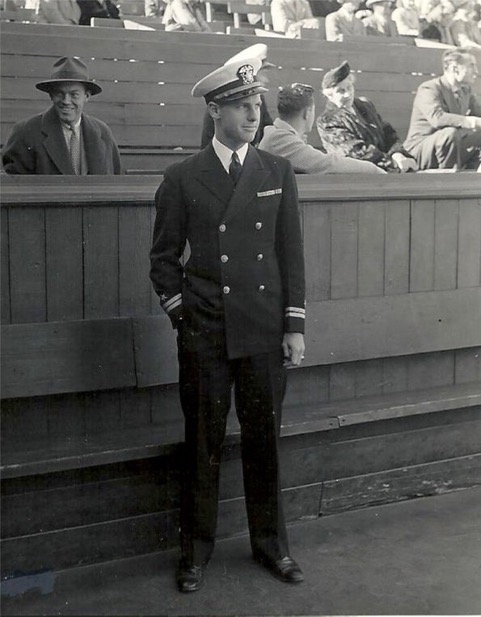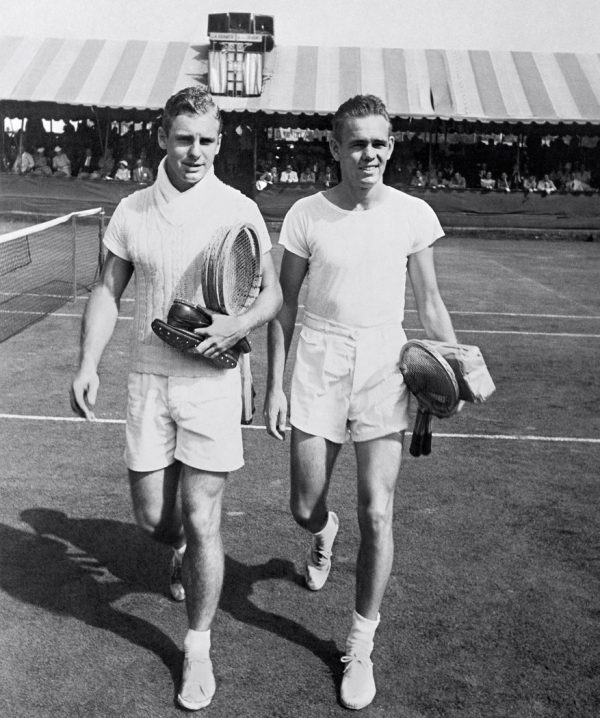In early July, the USTA announced that it would recognize a former champion on the day it annually fetes those who have dedicated portions of their lives to serving the country. There is a great deal more to story about the decision for the US Open to celebrate Lt. Joe Hunt Military Appreciation Day. It is much bigger than resolving to honor the 1943 US National singles champion whose extraordinary accomplishments have, for the most part, been lost to all, but a few who cherish the game.
In truth, this is a story about two “Joes”. But, it is much more meaningful then the days when “Joe” was slang for a good guy. It is more significant than a reference to an American soldier, and it surely does not relate to a mere cup of coffee. These Joes are special. They are distinctly different, yet very much alike. One easily could be a movie character straight out of Hollywood’s “Golden Age.” The other seems to be a regular Joe but has proven to be much, much more.
The first Joe is Joseph (Joe) R. Hunt. He was born in San Francisco, California but raised in Los Angeles. He had it all. Based on his looks alone – he was blond and blue-eyed and built like he worked out at Muscle Beach in Venice, California rather than on the Los Angeles Tennis Club courts-he was ready for the “Big Screen.”
However, there was a problem. He was also a great athlete. He won the National Boys’ 18 and 15 titles. By the time he was 17, his playing ability earned him a 1936 US Men’s Top 10 ranking. Playing No. 1 for USC, in 1938, he never lost a team singles or doubles match. He rounded out the season taking the NCAA Doubles Championship with teammate Lewis Wetherell.
He teamed with Jack Kramer in the 1939 Davis Cup against Australia. With the US leading, 2-0, the youngsters came up short in the critical match. John Bromwich and Adrian Quist, a veteran duo, triumphed 5-7, 6-2, 7-5, 6-2. (Australia, in the only time the country ever trailed 0-2 in the final, ended up claiming the Cup, 3-2.)
At the US National Championships played in Forest Hills, New York, that same year, Hunt was a singles semifinalist losing to Bobby Riggs, the tournament winner, 6-1, 6-2, 4-6, 6-1. In 1940, he was again a semifinals and Riggs again ended his run, narrowly slipping past him, 4-6, 6-3, 5-7, 6-3, 6-4.
Hunt was almost too good to be true. Besides his good looks and being a stellar player, he had charisma. And, people really liked him. What’s more, he was exceedingly realistic. He was aware of what was taking place in the world during the late ‘30s. His concerns led him to leave USC and transfer to the Naval Academy in 1939.

Two years later, Hunt was able to garner time from his duties and became the first (and only) player from the Naval Academy to win the NCAA Singles title. His military commitment kept him from participating in the US Nationals later in 1941 and again in ‘42.
But, he returned to Forest Hills in 1943. World War II was ravaging Europe and the Far East, so the US was only Grand Slam tournament held that year. As it turned out, the final between Hunt and Jack Kramer was a contest between two players on “leave”. Hunt represented the Navy and Kramer, the US Coast Guard.
On a brutally hot and humid day, the Naval Lieutenant downed the Coast Guard Seaman 6-3, 6-8, 10-8, 6-0. For both players, it was a heroic performance. When Kramer’s last shot sailed long, Hunt collapsed on the baseline of the worn grass at the Forest Hills with leg cramps. His opponent, who had suffered a bout of food poisoning during the tournament, slowly made his way to where the winner was sitting to shake his hand. It was a dramatic end to an unforgettable match.

The second Joe is Joseph (Joe) T. Hunt. He is the great-nephew of the first Joe. As is the case with almost all of those in the family, he grew up playing tennis. For him, it was in Santa Barbara, California. By trade, he is a lawyer, and practices in Seattle, Washington. He is also a member of the Pacific Northwest, (one of the 17 USTA sections), Board of Directors and serves as the Section Delegate.
Whenever he has an opportunity, Hunt heads to the court – not the legal one – but the one where he can play. He is as passionate about the game as he has been in leading the family’s effort to ensure that the first Joe isn’t forgotten.
His dedication to this quest has been “Clarence Darrow-like.” As the clever 20th Century lawyer, pointed out, “Chase after the truth like all hell and you’ll free yourself, even though you never touch its coattails.”
Initially, Hunt sought to have “The Original” Joe’s name added to the Court of Champions, located between the South Plaza and Courts 10 and 13 at the Billie Jean King National Tennis Center. According to the USTA website, “The US Open Court of Champions celebrates the legacy of the greatest singles champions in the history of the US Open and US Championships. Each champion defines the essence of the talent and the character required to win at tennis’ ultimate proving ground. Inductees, selected by media from around the world, represent the tournament’s all-time greatest “the best of the best” whose electrifying performances have contributed to making the US Open one of the world’s top sporting events.”
The facts reveal that the Court of Champions was launched in 2004 and prior to 2019 only eleven more enshrinements had taken place recognizing ten men and eight women.
Joseph R. Hunt was killed on February 2, 1945, fifteen days before his 26th birthday. He was on a training flight when his Navy Hellcat, a WWII combat aircraft, went into a spin at 10,000 feet. It crashed into the ocean off the coast of Florida. His body and the plane were never recovered.
The second Joe has done his utmost to see that the first Joe would be remembered. It hasn’t been an easy. He has been focused on the task since 2013 and has been aided by the entire Hunt family. Still, it has been a slog. Borrowing from Navy slang, throughout it all, he has always been “Above Board.”
As an example of the way he is, Hunt delighted in revealing, “I know that Joe was not the only player to not have a chance to defend his US National title. Ted (Schroeder) won it in 1942 and was not able to defend in 1943. They both were Navy pilots stationed in Pensacola, Florida. Neither was granted leave to play Forest Hills in 1944 so they both entered a Pensacola tournament held at the same time as the National Championships. Of course, the local tennis community couldn’t believe their lucky stars to have the 1942 and the 1943 champions playing a local event. It was billed as the ‘Clash of Net Champions’ and would supposedly determine the true No. 1 player in the country, despite that ‘other’ tournament taking place in New York.
“Joe and Ted both reached the final where ‘urban legend’ has it that they played their match in front of thousands of spectators on September 4, 1944, while Frank Parker was playing Bill Talbert in the final of Forest Hills – and winning 6-4, 3-6, 6-3, 6-3. I have spent hours trying to vet the truth of this story. I know that it is true, I just don’t know if it is 100% true that the two finals were played simultaneously. In any event, Joe beat Ted 6-4, 6-4. Despite what many have written, this was, in fact, the last tournament match of Joe’s life.”
Hunt pointed out, “Joe went out for football at the Naval Academy because he loved that sport too and wanted to be part of a team…”

But, as it is with many of the stories about the first Joe, there is much more to the tale…Imagine, in 1939, being one of the best tennis players in the country and, in the world for that matter, then deciding to play football and being assigned to the junior varsity. That’s what happened to Hunt. The next year, he played halfback on the varsity and was good enough to help the team achieve a six win, two loss, one tie season. In 1941, he was a standout on a team that finished with seven wins, one loss and one tie, and ended up ranked No. 10 by the Associated Press. Hunt played so well in the game against Army, (the Midshipmen’s third win in a row over the Cadets) that he was given a game ball signed by the entire team.
As mentioned in the beginning of this piece, Joe R. Hunt’s life, ( his death aside), was fairytale-like. As the second Joe recalled, “…He left his immensely successful life in Southern California to enter the Naval Academy, knowing that it would make it nearly impossible to achieve his dreams of becoming a great tennis champion… He put the right things ahead of the game.”
All of the Hunts are pleased that US Open Lt. Joe Hunt Military Appreciation Day will recognize a one-of-a-kind former tournament winner. Speaking for the Hunts the second Joe said, “The family of Lt. Hunt will be forever grateful to the USTA and the US Open leadership for taking this action to honor Joe by permanently assigning his name to the annual Military Appreciation Day.”
He further noted, “Connecting a real person to Military Appreciation Day will help the US Open achieve its inspiring purpose for the event, and there is no more fitting figure in the history of tennis to connect with the sport’s ideals of patriotism and sacrifice than Lt. Joe Hunt.”
Joe T. Hunt continues to believe that the first Joe’s life and the sacrifice he made for his country has earned him a place in the Court of Champions…and he also looks forward to collaborating with the USTA regarding how best to memorialize the lost aviator and other military service veterans at the Billie Jean King National Tennis Center.
Simply said. during a divisive period in the world, people like Lt. is Joseph (Joe) R. Hunt need to be remembered and not covered by the dust that results from the passage of time.

Cover of the March 1945 issue of American Lawn Tennis






